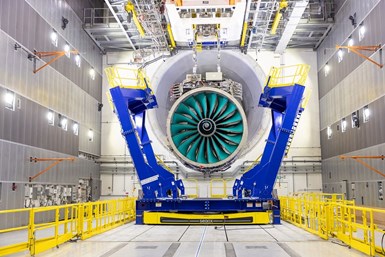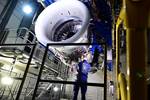Rolls-Royce prepares UltraFan technology demonstrator for testing
The UltraFan aeroengine, with a fan diameter of 140 inches, is designed with a suite of technologies to contribute to fuel efficiency for narrowbody and widebody aircraft.

Photo Credit: Rolls-Royce
In December 2022, Rolls-Royce (London, U.K.) announced its completed building of the UltraFan technology demonstrator. An important milestone for the program, the engine was transported from the build workshop and into Testbed 80 in Derby, U.K., where it was mounted in preparation for testing. The first test of the demonstrator is expected to take place early 2023, and will be operated using 100% sustainable aviation fuel (SAF).
UltraFan, which Rolls-Royce says will be the world’s largest aeroengine and will contribute to sustainable air travel, features what will be the world’s largest fan rotor blades made from carbon fiber-reinforced polymer (CFRP). More about its key engineering features here.
Combining a brand new engine design with a suite of technologies to support sustainable air travel for decades to come, the UltraFan demonstrator has a fan diameter of 140 inches and offers a 25% fuel efficiency improvement compared with the first generation of Trent engine, the company says.
The demonstrator offers a variety of sustainability solutions that will support the journey to net-zero aviation. In the nearer term, there are options to transfer technologies from the UltraFan development program to current Trent engines to deliver enhanced fuel efficiency and reductions in emissions. In the longer term, UltraFan’s scalable technology from ~25,000-110,000-pound thrust delivers the potential to further improve fuel efficiency of narrowbody and widebody aircraft by up to 10%.
Testbed 80, said to be world’s largest and smartest testbed, was designed and built especially to accommodate the size and technical complexity of the UltraFan demonstrator. It was opened in 2020 and has already completed many hours of experimental engine testing.
The UltraFan technology demonstrator program has been supported by the U.K.’s Aerospace Technology Institute (ATI) and Innovate UK, the EU’s Clean Sky program, plus LuFo and the state of Brandenburg in Germany.
Related Content
-
Automated robotic NDT enhances capabilities for composites
Kineco Kaman Composites India uses a bespoke Fill Accubot ultrasonic testing system to boost inspection efficiency and productivity.
-
Optimized rib-reinforced hollow composites via printed molds
Addyx topology optimization and water-soluble mandrel enables simultaneous rib and skin layup for one-shot, high-strength, lightweight structures.
-
Active core molding: A new way to make composite parts
Koridion expandable material is combined with induction-heated molds to make high-quality, complex-shaped parts in minutes with 40% less material and 90% less energy, unlocking new possibilities in design and production.
















